Lupine Publishers | journal of Surgery & Case Studies
Background: Implant failure refers to the inability of any
medical implant to meet the claims of its manufacturer or the health
care provider who installs it. Some implants tend to fail more than
others depending on location, type of implant and age of patient.
Other pathologies such as infection, trauma and pathologic fractures are
additional risk factors.
Objectives: To determine the pattern of orthopaedic implant failure and possible risk factors in a Nigerian tertiary hospital.
Methodology: A retrospective hospital-based study carried out over 10 years (January 2007 to December 2017) in which case notes of patients who had implant surgeries done were reviewed to determine those who had implant failure, the possible cause, treatment offered and outcome. Results were collated and subsequently analysed.
Results: Majority were females (60%) and mean age was 48yrs +/- 2.2. Most surgeries were in the lower limbs and Infection was the strongest single risk factor identified (40%). Revision surgery was carried out for all and majority (86.7%) were without bone grafts. However, all yielded satisfactory outcome.
Conclusion: Implant failure occurs more in the lower limb surgeries and affects middle aged females more. Infection is a strong risk factor however there is no association between aetiology and gender. Bone grafting in revision surgery does not affect outcome. The components of implants need to be further evaluated to determine risk of failure.
Orthopaedic implants are artificial mechanical devices that
are mounted to the skeletal system of the human body for various
purposes, such as supporting bone, replacing bones or joints
and reattaching tendons or ligaments [1]. Implant survival is the
time from the date of implant placement to the date of its failure
[2]. Implants are made of different types of biomaterials like
Titanium, stainless steel, polymers and composite materials. A
good biomaterial should have such properties as good mechanical
and biological compatibility and enhanced corrosion resistance [3].
An Implant is said to have failed when there is a need to remove the
implant prematurely [4].
A retrospective hospital-based study carried out in Wesley Guild
Hospital, Ilesha, in which case notes of patients who had implant
failure over a 10-year period (January 2007 to December 2017)
were retrieved, data such as demography, type of implant, cause
of failure and treatment offered were collated and enteredinto a
profoma and subsequently analysed. Statistical analysis was done
using simple frequencies and chi squared test for association.
During the study period, a total of 535 patients had open
reduction and internal fixation out of which 15 patients (2.8%)
were noted to have implant failure and subsequently had their
implants removed. This low incidence reflects the adequate concern
given for implant surgeries preoperatively, Intraoperatively and
postoperatively. The age ranged from 23years to 98 years with a
mean age of 48+/- 2.2 Previous studies done showed an average
age of 35 years in patients with implant failure [5]. This may be
attributed to the activity found more in this age group. The time
to implant failure ranged from 9days, to 16 months with a mean
of 3 +/- 4 months. In a study done in 2002, it was noted that most
failures occur less than 2 years following the initial surgery [6].
Time to weight bearing following implant removal ranged from 1
month to 5 months with a mean of 2.7+/- 1.1 months (Figure 1).
The Figure 1 above shows the gender distribution of patients with implant failure. It is noted that 40% of the patients were males while 60% were females.
This finding is similar to a study done in 2009 where it was noted that females are at higher risk of early implant failure [7]. This could be due to their higher body mass index thus putting more stress on the implants (Tables 1-3). The frequency table above shows the nature of implants that failed over the study period and the causes of failure (Figure 2). It is noted that most of the implants were in the lower limbs, this could be attributed to the lower limb bearing the body weight and hence the implant sharing the weight. It is noted that plates and screws had the highest incidence, (53.3%). This could be explained by plates and screws being load sharing devices as against nails which are load bearing devices. There was an equal incidence for spine implants, locked intramedullary nails, Dynamic hip screw and corrective osteotomy implants (6.7%). There is however paucity of data regarding nature of implants which commonly fail rather it is more of the contents of the implant [8].
Regarding aetiology, infection was noted as the commonest cause of implant failure while in another study, smoking was noted as a strong risk factor for implant failure [9]. The use of postoperative antibiotics does not reduce the chances of implant failure [10]. Thus, proper preparation of the patient and implant selection are important. Pathologic fracture, trauma and implant exposure had equal incidence of aetiology accounting for 8.3%. In a study by K.V Sudhakar, it was noted that stainless steel intramedullary nail could fail due to ductile fracture facilitated by presence of non-metallic inclusions [11]. in another study, it was noted that solubility of Titanium is a cause of implant failure [12]. On further analysis, we can inffer, that there is no association between gender and implant failure given a p value of 4.3 and x2 of 3.77. It is also noted that 86.7% did not have bone grafting done however, there was satisfactory outcome in all the cases which supports studies done in literature [13].
Implant failure occurs more in the lower limb surgeries and
affects middle aged females more. Infection is a strong risk factor
however there is no association between aetiology and gender.
Bone grafting in revision surgery does not affect outcome. The
components of implants need to be further evaluated to determine
risk of failure.
Abstract
Objectives: To determine the pattern of orthopaedic implant failure and possible risk factors in a Nigerian tertiary hospital.
Methodology: A retrospective hospital-based study carried out over 10 years (January 2007 to December 2017) in which case notes of patients who had implant surgeries done were reviewed to determine those who had implant failure, the possible cause, treatment offered and outcome. Results were collated and subsequently analysed.
Results: Majority were females (60%) and mean age was 48yrs +/- 2.2. Most surgeries were in the lower limbs and Infection was the strongest single risk factor identified (40%). Revision surgery was carried out for all and majority (86.7%) were without bone grafts. However, all yielded satisfactory outcome.
Conclusion: Implant failure occurs more in the lower limb surgeries and affects middle aged females more. Infection is a strong risk factor however there is no association between aetiology and gender. Bone grafting in revision surgery does not affect outcome. The components of implants need to be further evaluated to determine risk of failure.
Introduction
Methodology
Results/Discussion
The Figure 1 above shows the gender distribution of patients with implant failure. It is noted that 40% of the patients were males while 60% were females.
This finding is similar to a study done in 2009 where it was noted that females are at higher risk of early implant failure [7]. This could be due to their higher body mass index thus putting more stress on the implants (Tables 1-3). The frequency table above shows the nature of implants that failed over the study period and the causes of failure (Figure 2). It is noted that most of the implants were in the lower limbs, this could be attributed to the lower limb bearing the body weight and hence the implant sharing the weight. It is noted that plates and screws had the highest incidence, (53.3%). This could be explained by plates and screws being load sharing devices as against nails which are load bearing devices. There was an equal incidence for spine implants, locked intramedullary nails, Dynamic hip screw and corrective osteotomy implants (6.7%). There is however paucity of data regarding nature of implants which commonly fail rather it is more of the contents of the implant [8].
Regarding aetiology, infection was noted as the commonest cause of implant failure while in another study, smoking was noted as a strong risk factor for implant failure [9]. The use of postoperative antibiotics does not reduce the chances of implant failure [10]. Thus, proper preparation of the patient and implant selection are important. Pathologic fracture, trauma and implant exposure had equal incidence of aetiology accounting for 8.3%. In a study by K.V Sudhakar, it was noted that stainless steel intramedullary nail could fail due to ductile fracture facilitated by presence of non-metallic inclusions [11]. in another study, it was noted that solubility of Titanium is a cause of implant failure [12]. On further analysis, we can inffer, that there is no association between gender and implant failure given a p value of 4.3 and x2 of 3.77. It is also noted that 86.7% did not have bone grafting done however, there was satisfactory outcome in all the cases which supports studies done in literature [13].
Conclusion
For more Lupine Publishers Open Access Journals Please visit our website:
For more Surgery Journal articles Please Click Here:
To Know More About Open Access Publishers Please Click on Lupine Publishers
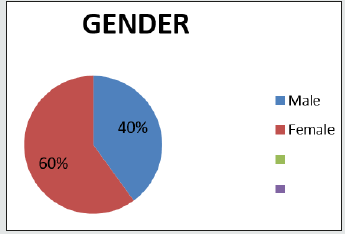
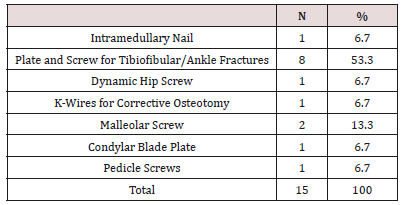
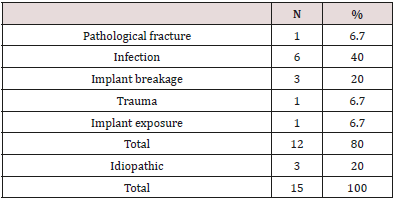
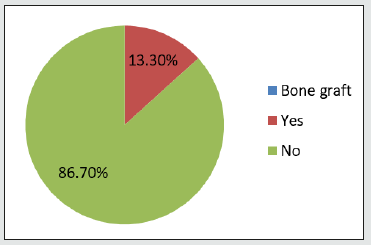
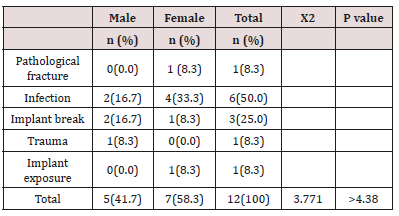

No comments:
Post a Comment